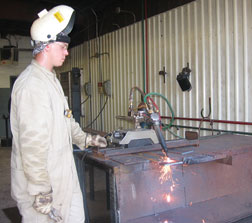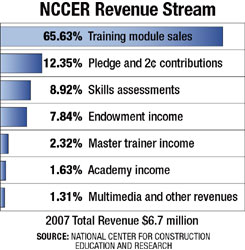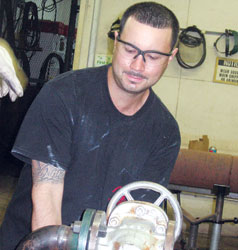...NCCER founder: “Some of our people have union cards. Others don’t. The quality is there in the basic trades, but not in all of them. You want to make sure people are trained, but it may not take a four-year apprenticeship.”
 National Center/Construction Education & Research Ironworker Charles is using NCCER training to expand into new craft skill areas.
|
NCCER has struck a particular chord with the owner community, with strong ties to groups such as the Construction Users Round Table, made up largely of industrial and power companies. “NCCER has the capability to listen to the demands of owners,” says Yarbrough, a board member who also is site manager of the sprawling Exxon/Mobil Corp. refinery in Baytown, Texas, the largest in the U.S. “We expect to do 10 million work hours of construction improvements and maintenance,” says Yarbrough. “We’re looking for high-skilled workers who can be productive, and we need ways to verify that. NCCER training is consistent and highly measurable. I can take that to the bank.”
Helping owners and contractors meet bottom-line goals has generated close to $6.7 million in revenue for NCCER, mostly through sale of materials but also in 16¢-per-hour contributions from 75 contractors with which it has national training agreements and other streams. Two cents of each firm’s contribution funds NCCER’s 40-member staff, with one cent now earmarked for craft recruitment efforts. The nonprofit group also has a $10.8 million endowment as a “safety net,” says Whyte.
 National Center/Construction Education & Research Welding is among trades in need for energy construction.
|
NCCER’s inroads into high-school-level training could be a boon for industry recruiting efforts while offering schools a substitute for the lack of vocational education programs. Worsham, a vice president at Haskell, notes that he was recruited by the firm in high school as a carpenter and rose up to management. Even without a college degree, he recently earned an executive MBA from Jacksonville University. “A training program creates loyalty in the business,” he says. “It’s empowering. When I tell parents that, they’re blown away.”
The Okaloosa County, Fla., school district’s CHOICE program uses NCCER curricula for its well-regarded Construction Technology Institute. “It’s a credential that sets our students head and shoulders [above] kids coming out with a typical vocational training program” says Matt Clark, institute dean. Nearly 1,100 juniors and seniors have received NCCER certification since the school opened in 2004.
The curriculum creates some competition among students as to who can achieve the certificate first, Clark adds. When students succeed, they receive a decal to place on their hardhats. The Florida Legislature recently passed new educational requirements to include certifications. CHOICE now receives additional state funding for every student who gets certified.
 | “We work with everyone and don’t take sides. We must recruit as an industry.” — Don Whyte, NCCER president
|
John Easley, state career and technical education program director for the Louisiana Community & Technical College System, says NCCER’s modular curriculum is well suited to students who often have to interrupt their education to join the workforce. “It offers them an opportunity to come back to us throughout their lives to continue to build on their skill sets through the journeyman level,” he says. “One of the key elements is the validation. The accountability is there and so is the quality.”
Even so, NCCER proponents acknowledge the industry’s uphill battle in changing its image. “We have to convince young people in this country that construction is an honorable career,” says Rick Graves, Fluor Corp. senior vice president of global services. “We’re also not communicating that it’s a technology-driven business.”
 |
The group has pushed an annual “construction careers week” since 2005, and next year will launch a bigger recruiting campaign, “Choose Construction.” The effort is to be led by CURT, contractor groups and possibly AFL-CIO’s Building and Construction Trades Dept.
The union movement is watching NCCER efforts, which, while facing its own manpower and political challenges, are loathe to lose ground to the open shop in traditional markets or new ones, such as nuclear power construction. Whether owners can nudge the two sides closer remains to be seen.
Even so, some local unions are buyers of NCCER materials. The South Central Laborers’ Training and Apprenticeship Fund, a union-management group in Livonia, La., near Baton Rouge, is an NCCER sponsor now involved in master-level certification training for union members and nonmembers, says Gary Slaydon, administrator and director.
 | “We must raise industry economics and cut off the valve of contractors using illegal workers.” — Sean McGarvey, Building Trades official
|
Training includes mobile “classrooms” in tractor-trailers equipped with satellite dishes to facilitate computer labs and allow off-site training managers to monitor instruction quality. “We recruit and train to do what we have to for the market,” he says. “We want to do the best for the folks we represent. When I see all the H-2B visa requests, I get upset.”
But building-trades training officials say nonunion investment pales in relation to that of union contractors, who contribute cents per hour for training even if they do not have any apprentices. Michael I. Callanan, executive director of the building trades’ National Joint Apprenticeship and Training Committees, questions whether NCCER training meets the same level of craft certification as union programs must. “What they offer is a quick fix and a ‘solution’ to the workforce shortage,” he claims. “How can they do it with the new scope of projects ahead?”
 NC/Construction Education & Research On-site learning will be aided by web technology.
|
Callanan notes major changes on the horizon in late fall when new U.S. Labor Dept. apprenticeship rules take effect and finally catch up with U.S. economic and technological trends. They will be the first significant changes to apprenticeship in 30 years, including distance learning, blends of competency and class hours, interim credentialling and “performance standards” says the agency.
Union officials claim that construction industry economics is what hurts recruitment. “We don’t think there’s a shortage of Americans who want to work in construction,” says Sean McGarvey, BCTD secretary-treasurer. “The answer is, raise the economics and cut off the valve of contractors using illegal workers.” Union officials are reportedly close to a deal with several major utilities for nuclear powerplant work that will incorporate into bid documents regional wage, benefit rates and training funds, sources say. The agreement would integrate plant construction and operation personnel. “It’s an innovative, out-of-the-box agreement,” says one union official.
But NCCER proponents see a tough challenge ahead for everyone. “He who trains will dominate the industry of the future,” says Halverson. “It’s more true now than ever.”

Post a comment to this article
Report Abusive Comment